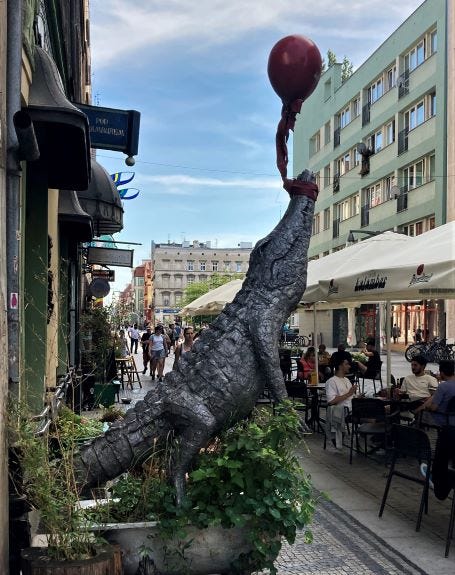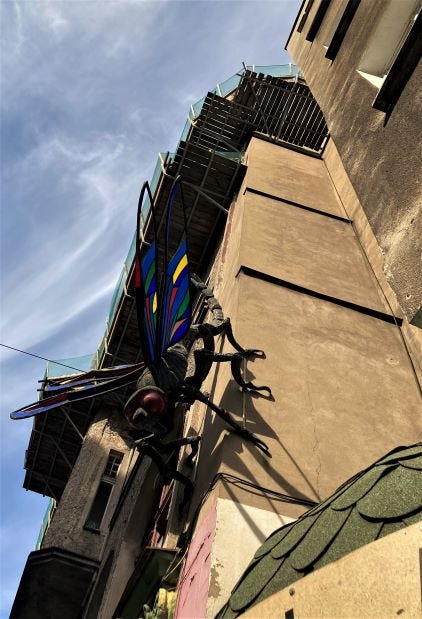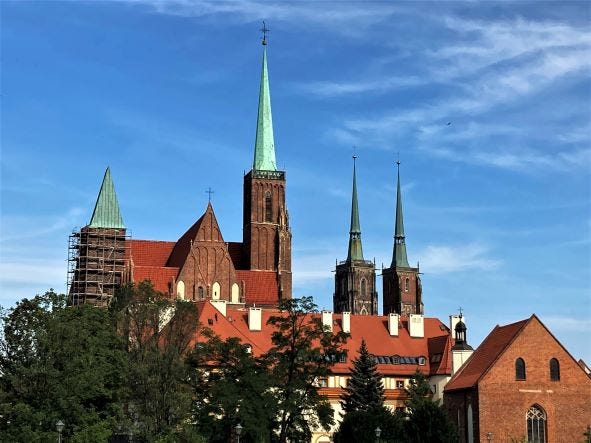I’ve only been in Wrocław for 4 days, and I’ve already had several people tell me that the Polish language is incredibly difficult to learn. For one thing, while the Polish alphabet looks tantalizingly familiar on street signs and restaurant menus, it has 28 characters (I think), not the 26 we’ve learned in the U.S. And there are plenty of little squiggles and accent marks and slashes that apparently change those familiar-looking letters into something else entirely when you hear them.
The city name, for instance: Wrocław. But it doesn’t sound like Wrocław. It sounds like “VROTE-swoff” (with a rolled “r”). So, there’s that.
Then there’s the street I walked to get home today: Swidnicka. It’s a lovely cobblestone boulevard that runs right through the old city center. For much of its length, it’s blocked off to all traffic but pedestrians and bicycles. It’s lined with shops and cafes and nifty old buildings. Swidnicka.
It’s “Schvid-NEECH-ka,” more or less.
But however you say it, I like it:
There are some nifty sculptures on Swidnicka, like this parade of not-entirely-happy-looking people breaking out through the sidewalk to head west down Marszalka Jozefa Pilsudskiego (“skiego” in a street name indicates that the street is named after a famous man—in this case, Marshall Jozef Pilsudski, statesman and father of the Second Polish Republic established in 1918):
Or this playful alligator (crocodile?) outside a café:
And the pony-sized dragonfly hanging from the side of the building overhead:
Then, too, you don’t have to spend much time in Wrocław to see what a Big Deal the Catholic Church is in Poland—churches (and nuns in habits) seem to be on every corner. And they’re big tall imposing churches, too, like the Church of St. Stanislaw and St. Dorothy right on Swidnicka:
There are also monuments to more secular values, like the Museum of Bourgeois Art:
(Isn’t art supposed to embody a rejection of bourgeois values? Or did I just listen to too much Puccini?)
My walk up Swidnicka (which runs generally north-south) eventually brought me closer to home, where I had to cross the Oder River to the north bank via a series of bridges connecting several small islands. And looming over the skyline, more Catholic churches—this one is the Archikatedra sw. Jana Chrziciela (the Cathedral of St. John the Baptist), the seat of the local archdiocese.
But apparently, having a cathedral on the block (even one serving as the seat of an archdiocese) isn’t enough by itself, because just down the street is the Collegiate Church of the Holy Cross and St. Bartholomew (the bright single spire in the foreground, just to the left of the Cathedral’s double spires):
And I haven’t even mentioned the other churches that fill up the city center islands and surrounding riverbank, like the Roman Catholic Church of St. Martin, and the Roman Catholic parish church NMP on the sand (whatever that means). All 4 of these last churches fit inside a circle 500 yards in diameter.
All of this makes for an interesting juxtaposition with Google’s corporate headquarters less than half a mile away:
(Can you guess which building is Google?)
And there, on the ground floor of Google’s corporate headquarters in Wroclaw, is the local bank where I’ll be opening an account tomorrow, after managing (with help from my school) to negotiate the bureaucracy surrounding the assignment of PESEL numbers (basically the Polish equivalent of a social security number).
Which means, soon, Cathy and I will have access to Poland’s national healthcare system. For free.
Free health care. A clean efficient public transit system. A city filled with cathedrals and museums and cobblestone streets, and kebab stands, and milk bars, and all kinds of groovy stuff.
I guess living with a refrigerator the size of a footstool might be a decent tradeoff for all of that.













Groovy!
I'd be interested in your personal experience with the National Healthcare of Poland. I've always had interest in "free healthcare".